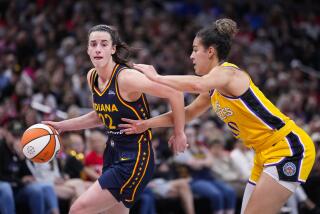Welcome to Basketball’s Version of ‘Sister, Sister’
- Share via
I’m on the phone with somebody from the American Basketball League, a professional women’s league, when Call Waiting clicks.
“Excuse me a second,” I say to the first person.
“Hello?” I say to the second.
It is somebody from the Women’s National Basketball Assn., the other women’s professional league.
Oh, my. My palms dribble. My stomach leaps. What should I do? Do I tell the woman from the WNBA that her highly publicized league is not worthy of my immediate attention, that I will call her back?
Or do I hang up on the person from the ABL, implying that its inaugural season last winter was a bust?
Do I go with the big sponsorships of the WNBA? Or the big money of the ABL?
The WNBA’s Los Angeles Sparks? Or the ABL’s Long Beach No-Nickname-Yet-But- Give-Us-A-Few-Minutes-Willya?
I tell the WNBA I will call back. I finish my conversation with the ABL. I hang up the phone. I throw up my hands.
I love the textbook beauty of women’s basketball. I am excited that it has finally returned to this country at the professional level, bringing opportunity and hope.
But why couldn’t it have returned in one body?
Why did it have to come back as nasty twins, needling each other and stealing from each other and ultimately diluting the character of each other?
After years of waiting for one pro league, why should I suddenly have to choose between two?
Well, maybe I won’t.
Maybe I’ll get so confused, I’ll choose neither.
The worry of both Southland teams should be that after the novelty wears off, the average fan will feel the same.
The Los Angeles Sparks begin play next month at the Forum. They will feature former USC standout Lisa Leslie and a 6-foot-9 woman from China named Zheng Haixia, meaning somebody is going to be dunking.
Their league--teams from eight NBA cities playing a 28-game schedule--will feature four of the 12 women from the 1996 gold-medal Olympic team, including Rebecca Lobo and a very pregnant Sheryl Swoopes.
But it is not the best of women’s basketball.
The Long Beach No-Nickname-Yet-But- Don’t-Expect-Something-As-Cool-As-Ice-Dogs begin play in October at the Pyramid.
That team will feature former Olympian Venus Lacy and last year’s Final Four MVP, Michelle Marciniak of Tennessee.
The ABL has eight of the 12 Olympians, plus the two best women players in college basketball last year, Kara Wolters of Connecticut and Kate Starbird of Stanford.
But it is not the best of women’s basketball.
The WNBA has a national television package, NBA arenas and a schedule that will compete only with baseball.
The ABL has better players, pays up to three times as much as the WNBA, and averaged 3,536 fans a game in its first season.
But it is not the best of women’s basketball.
Only together are these leagues the best of women’s basketball.
Separate? Just a guess, but only junkies are buying tickets for women’s basketball games in both July and January.
Not that women are complaining. Two leagues mean double the jobs, double the role models. Women’s basketball has gone from nothing to everything in less than a year.
“It’s a win-win situation for a lot of people,” said Julie Wilhoit, women’s coach of Loyola Marymount and purveyor of perspective.
“Women who want to play basketball after college can stay in this country. Young girls who are used to watching Michael Jordan can now watch Sheryl Swoopes, can dream about being her.
“And it’s not just one opportunity for all of this, but two. If both leagues can survive, more power to them.”
But you know they won’t.
The bidding war has been like manna for long-suffering women athletes--the best are getting as much as $150,000 a year--but wait until those athletes realize that the business types have no idea about tomorrow.
Somebody is going to fail, and the entire sport will be stained.
Somebody is going to win, but, by then, there will be no winners.
Hasn’t the game spent too many seasons losing too much sweat to become just another two-year quickie?
The competition for women basketball players should be traditional sports, narrow minds, ugly stereotypes. The competition should not be each other.
The ABL quietly wonders how the WNBA can promote a player who is due to give birth on the day of the league opener.
The WNBA quietly wonders if anybody has ever actually seen an ABL player or game, implying that those who signed there chose money over exposure.
The ABL was first, planned by a Bay Area ad agency before the Olympics.
The WNBA, despite claims four years ago by Commissioner David Stern that he was interested, didn’t announce its plans until after the Olympics.
“I think there is room for both,” Stern said last week, smiling, patronizing.
The theme of the WNBA is “We Got Next.”
These opportunistic suits from both leagues, throwing fast food at starving women, the last thing they are thinking about is next.
More to Read
Go beyond the scoreboard
Get the latest on L.A.'s teams in the daily Sports Report newsletter.
You may occasionally receive promotional content from the Los Angeles Times.











